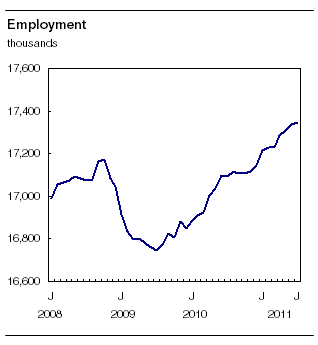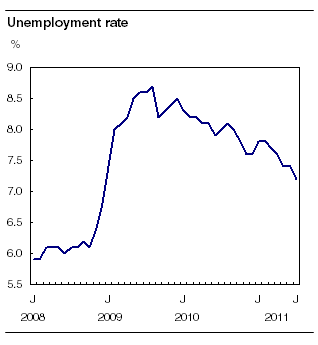Labour Force Survey
Archived Content
Information identified as archived is provided for reference, research or recordkeeping purposes. It is not subject to the Government of Canada Web Standards and has not been altered or updated since it was archived. Please "contact us" to request a format other than those available.
Related subjects
-
[an error occurred while processing this directive]
Following three consecutive months of increases, employment was little changed in July. The unemployment rate declined by 0.2 percentage points to 7.2%, as fewer people participated in the labour market.

Employment increased by 252,000 (+1.5%) compared with July 2010, with the growth in full time and among private sector employees.
In July, employment increased in construction, transportation and warehousing as well as retail and wholesale trade. At the same time, there were decreases in health care and social assistance; educational services; business, building and other support services; natural resources as well as agriculture.
An increase in the number of private sector employees was offset by a decline in the public sector.
There were more people working in Alberta and in Newfoundland and Labrador in July, while there was a decline in Ontario. There was little or no change in the other provinces.
In July, younger students aged 15 to 16 experienced more difficulty finding work than their older counterparts. Their unemployment rate was similar to that of July 2009, while the rate for students aged 20 to 24 dropped by half.

Chart description: Unemployment rate
Note to readers
Labour Force Survey (LFS) estimates are based on a sample, and are therefore subject to sampling variability. Estimates for smaller geographic areas or industries will have more variability. For an explanation of sampling variability of estimates, and how to use standard errors to assess this variability, consult the "Data quality" section of the publication Labour Force Information (71-001-X, free).
Seasonal adjustment and educational services
Unless otherwise stated, this release presents seasonally adjusted data, which facilitates comparisons by removing the effects of seasonal variations.
The LFS seasonal adjustment process removes the "average" seasonal pattern in the monthly data, according to trends seen in the previous seven years. While there have been large movements in educational services employment in summer months in recent years, there has not been a consistent pattern in the direction or magnitude of these changes over the seven-year period.
Gains in construction, transportation and warehousing
Employment in construction rose by 31,000 in July, following three months of little change. This increase brings gains over the past 12 months to 66,000 (+5.3%).
Employment in transportation and warehousing rose for the second consecutive month, up 28,000 in July. Compared with 12 months earlier, employment in transportation and warehousing increased by 7.2%, the highest growth rate of all industries.
There were 28,000 more people working in retail and wholesale trade in July. Despite this increase, employment in this industry remained similar to its level of a year earlier.
Employment in manufacturing edged up in July. Over the past 12 months, the number of workers in this industry rose by 1.2% (+22,000).
Following a long-term upward trend, employment fell by 39,000 in health care and social assistance in July. This decline leaves employment in the industry slightly above its level of July 2010 (+0.7%).
Employment in educational services declined by 30,000 in July, all in elementary and secondary schools (see Note to readers).
Employment also decreased in July in business, building and other support services (-14,000), natural resources (-11,000) as well as agriculture (-9,000).
More private sector employees
The number of employees in the private sector increased for the fifth consecutive month, up 95,000 in July. This brings total gains from 12 months earlier to 241,000 (+2.2%). In contrast, employment in the public sector fell by 72,000 in July, leaving the number of employees in the sector 0.9% above the level of 12 months ago.
Self-employment edged down in July, bringing the number of self-employed slightly below its level of 12 months ago (-0.7%).
In July, increases in full-time employment were mostly offset by declines in part-time work. Over the last 12 months, full-time employment has grown by 351,000 (+2.6%) while part time has declined by 99,000 (-2.9%).
Employment increases in Alberta
Employment in Alberta rose by 12,000 in July, the third consecutive monthly increase. Employment in the province is now 3.8% higher than 12 months earlier. This is the highest growth rate of all provinces and higher than the national average of 1.5%.
Following two consecutive months of decreases, employment in Newfoundland and Labrador increased by 3,800 in July. Compared with 12 months earlier, employment in the province has grown by 3.5%, the second highest growth rate in the country.
In Ontario, employment declined by 22,000 in July. Despite this decline, employment growth over the past 12 months stands at 1.6%, similar to the national growth rate. The unemployment rate fell by 0.2 percentage points to 7.5%, the result of a decrease in the number of people participating in the labour market.
While employment in Quebec was little changed in July, the unemployment rate fell by 0.7 percentage points to 7.2%, mostly the result of fewer people in the labour market in search of work. Compared with 12 months earlier, employment in the province increased by 1.5%, the same as the national rate of growth.
Student summer employment
From May to August, the Labour Force Survey collects labour market information about young people aged 15 to 24 who were attending school full time in March and intend to return to school in the fall. The published estimates are not seasonally adjusted; therefore, comparisons can only be made on a year-over-year basis.
Employment for students aged 15 to 24 was little changed in July compared with 12 months earlier. In July 2011, the unemployment rate for students was 17.4%, similar to that of July 2010. This was lower than the rate of 20.8% observed in July 2009, a time when the student labour market was particularly affected by the labour market downturn.
In July 2011, younger students experienced more difficulty than their older counterparts in finding work. The unemployment rate among students aged 15 to 16 was the highest among all students at 32.7% and was similar to their rate of July 2009.
Among 17- to 19-year-olds, the unemployment rate was 17.6%, lower than the rate of 19.9% in July 2009. For students aged 20 to 24, it was 7.1%, about half the rate of 13.3% observed two years earlier.
Available on CANSIM: tables 282-0001 to 282-0042, 282-0047 to 282-0063, 282-0069 to 282-0095 and 282-0100 to 282-0121.
Definitions, data sources and methods: survey number 3701.
A more detailed summary, Labour Force Information (71-001-X, free), is now available online for the week ending July 16. From the Key resource module of our website under Publications, choose All subjects, then Labour. LAN and bulk prices are available on request. The DVD-ROM Labour Force Historical Review, 2010 (71F0004X, $209), is now available. See How to order products.
Data tables are also now available online. From the Subject module of our website, choose Labour.
The next release of the Labour Force Survey will be on September 9.
For general information or to order data, contact Client Services (toll-free 1-866-873-8788; 613-951-4090; labour@statcan.gc.ca). To enquire about the concepts, methods or data quality of this release, contact Vincent Ferrao (613-951-4750; vincent.ferrao@statcan.gc.ca) or Lahouaria Yssaad (613-951-0627; lahouaria.yssaad@statcan.gc.ca), Labour Statistics Division.
- Date modified:
